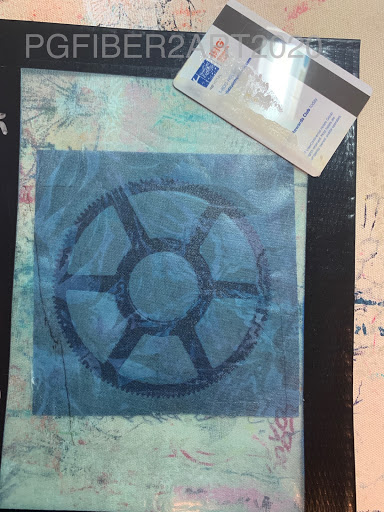We all (or most of us!) love color, don't we? But sometimes we want to take color away - to create interest or contrast or the illusion of shadows. Or just because it's a fun technique. The process of doing this is called DISCHARGE, and it can be done with various products. We have selected 3 products to illustrate using this process with Thermofax screens.
But wait - there are more than 3 products in that picture! Let me explain. DeColourant by Jacquard is a product formulated for discharge and can be used right out of the container. It's consistency is perfect for using with Thermofax screens. It involves a 2-step process - applying the product and allowing it to dry (it can still be damp), then applying heat and steam with an iron to activate the color removal. the longer you steam it, the more color comes out. You can stop at any point when you are happy with the color change. The one drawback to this product is the odor - it does need to be used in a well-ventilated space.
Bleach gel also works well to discharge, however this product is rather thin for use with a screen. To solve that problem, it can be thickened with sodium alginate which you see in the packet on the left. This is the same product used to make thickened dye, so if you do any dye printing, you may have some on hand. Just sprinkle a bit into the gel and stir to thicken; add a little bit at a time until you have the right consistency. Because this is a bleach product, you need to drop your fabric in an anti-chlor solution to stop the color change. (That is the product on the right in the back, from ProChem.) If you don't stop the action of the bleach, it will continue to eat away at the fibers and may result in holes.
The 3rd product is a bleach pen. If, instead of discharging through screens, you want to draw patterns on fabric, this is a good choice. But you could also use it with screens if you don't have any other products; just use it to apply the bleach to the screen and then spread it with a squeegee, or be selective about the parts of the screen you use it on. The pen has a "fine" tip and a brush tip. The word "fine" is in quotes because "fine" is relative. Don't expect thin lines. As with the bleach gel, this product needs to be neutralized with the anti-chlor.
Though we didn't use it in this activity, Cascade dishwasher detergent is another product that contains bleach that can be used for discharge. Sources for products are linked above. The bleach gel and pen are from the local grocery store.
Now that you have some background on products, let's see what results they produce. First, apply the product through the Thermofax screen just the same as you do for paint and other products.
So, what will you discharge? If you try this technique, we'd love to see pictures of your results. Share in the comments here or on our Facebook page. Just be sure to work in a well - ventilated area, especially when ironing the discharge. Sue found that working next to a screen door with a fan blowing out helped dispel the aroma. And be sure to have some anti-chlor on hand to stop the bleach action of the other products. That being said, have fun!This gear screen was used with the bleach gel.
These are 2 batiks that were discharged. The fun part of this technique is that you never know exactly what you're going to get. Some fabric dyes discharge better than others. Some turn unexpected colors. Blacks from different manufacturers may give you totally different results. Different products may give different results - you'll see that in the photo below.
This piece shows the bleach gel gear discharge at the top. The bottom is a boiler wheel screen done with deColourant. What different color results! We purposely kept these prints together so you could see they're on the same piece of fabric. Again, you never know what results you will get.
Here are 2 more examples of the boiler wheel on batiks. Noticeably the red provides a much sharper print. After those 2 products it was time to play with the bleach pen. Each of the following pictures shows the pen applied on the left, and the rinsed, dry print on the right. (Note: these are doodle designs rather than Thermofax screens.)
Unlike the deColourant, the bleach products will effect the change within minutes. Just keep your eye on it and when you are satisfied with the color change, drop it in the anti-chlor solution.
One final picture, you may be wondering how to apply this technique to your art quilts, so here's an example.
The leaves here were discharged with deColourant after the background was sewn together.










No comments:
Post a Comment